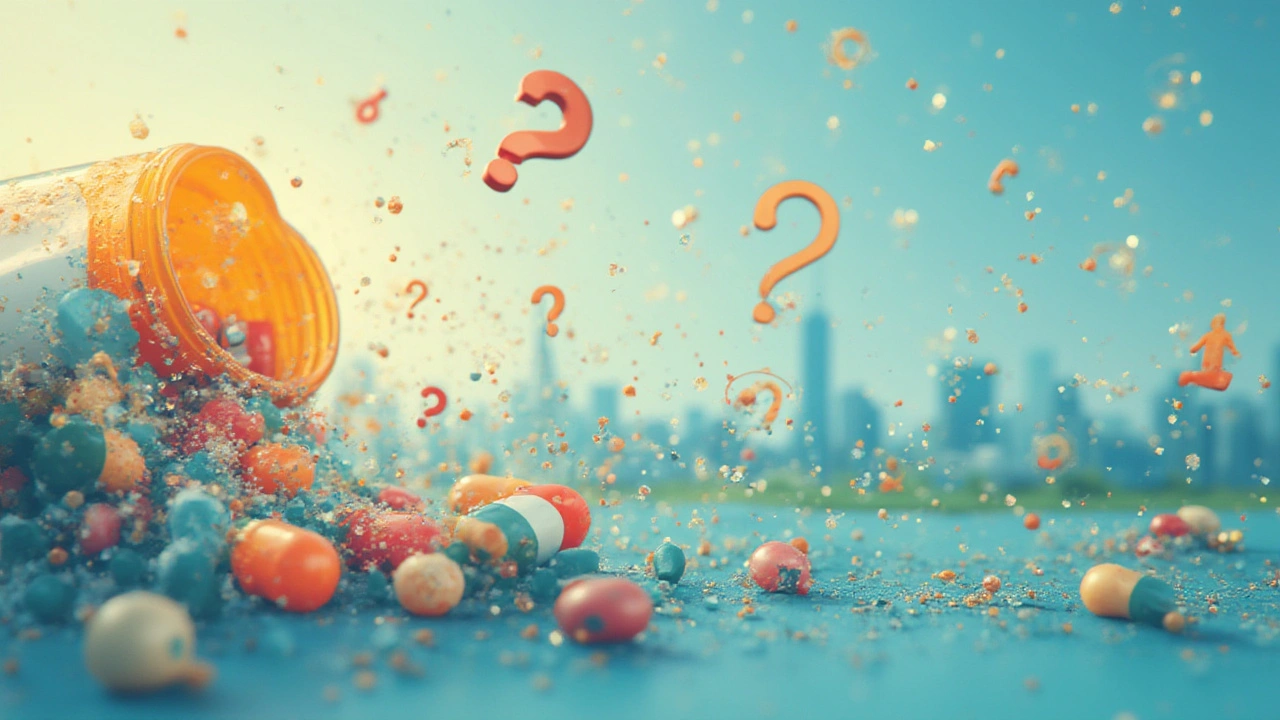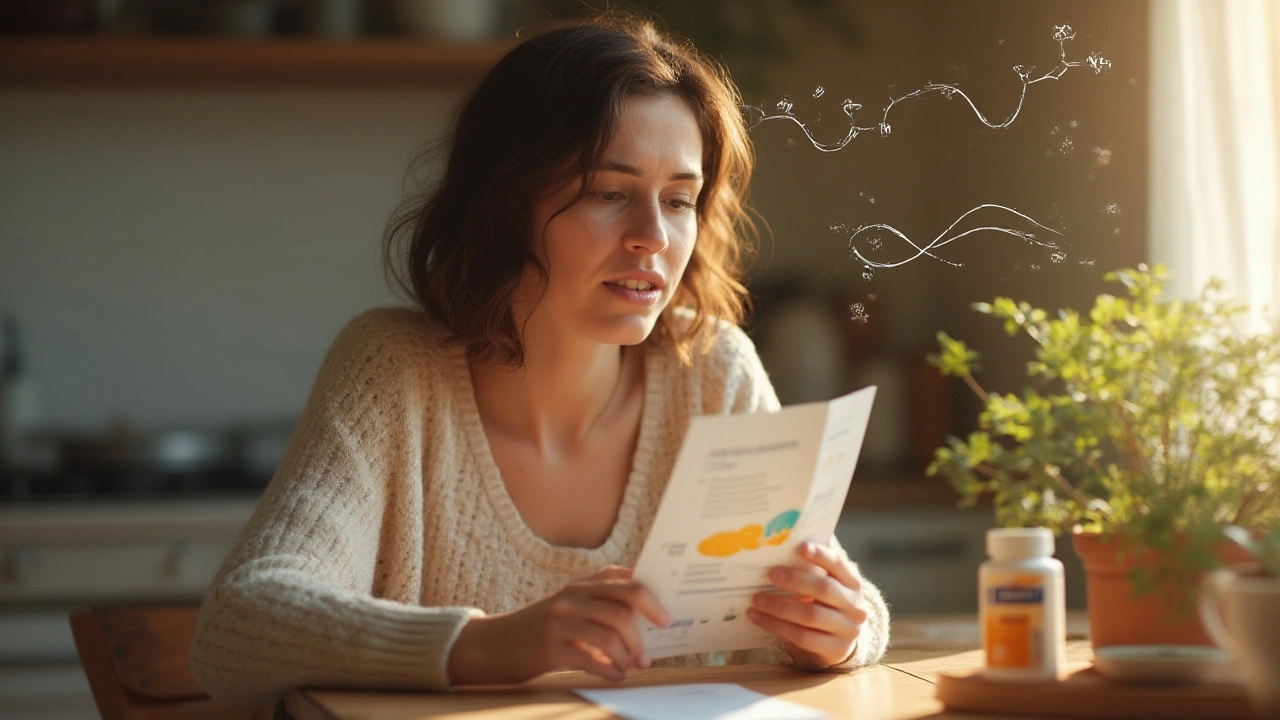Kids get nervous before summer camp, just like adults get twitchy before speaking in meetings. And almost everyone knows someone (maybe yourself) who’s reached for Benadryl, thinking that familiar pink pill will take the edge off, not just allergies but anxious jitters, too. It’s cheap, easy to buy, and way less scary than a prescription anti-anxiety med. But here’s a reality check: does Benadryl, with its active ingredient diphenhydramine, actually calm you down? Or is that sleepy side effect just masking deeper issues?
How Diphenhydramine Changes Your Brain Chemistry
Let’s get into the science. Diphenhydramine, the active ingredient in Benadryl, is a first-generation antihistamine. That means it doesn’t just block histamines (which cause allergy symptoms), it also crosses the blood-brain barrier and slows things down in your nervous system. The result? Drowsiness, sometimes a lot of it. That sedative punch is honestly why so many people in the U.S. use Benadryl as a makeshift sleep aid. In fact, roughly 20% of adults admit to using over-the-counter sleep products like diphenhydramine each month.
But when it comes to anxiety, the story gets more complicated. While Benadryl can make you sleepy, it doesn’t target anxiety the way drugs like benzodiazepines or SSRIs do. True anti-anxiety meds work by tuning the brain’s chemical messengers, especially gamma-aminobutyric acid (GABA), which actively quiets the nervous system and tamps down racing thoughts. Diphenhydramine doesn’t do much of that. Instead, it blocks acetylcholine, a neurotransmitter related to alertness and muscle movement. That’s why taking Benadryl feels like you’re turning the volume knob down on the outside world—your body gets woozy, your mind feels foggier, but the root anxiety process is still running in the background.
This matters because, while you might feel calmer right after taking Benadryl, what you’re experiencing is more like a haze than real calm. It’s sedation, not true relief. And with repeated use, your tolerance builds up fast. The body adapts, so the more often you use Benadryl to chill out, the less dramatic that zonked-out feeling gets. One especially eye-opening study from JAMA Internal Medicine found that regular use of strong anticholinergic medications like Benadryl is actually linked to a higher risk of dementia later in life—enough to make you reconsider what you reach for in the medicine cabinet.
Still, Benadryl can start to take the edge off jittery nerves, especially if your anxiety feels closely tied to physical symptoms like itching, hives, or insomnia. For true generalized anxiety disorder, or panic symptoms, though, Benadryl isn’t a first-choice option according to any major medical guidelines. It might dull the sensation a little, but it doesn’t tackle those stuck loops of worry that hijack your brain.

The Truth About Using Benadryl for Anxiety—And the Side Effects no One Talks About
Here’s where myth meets risk. People frequently search for answers like does Benadryl calm you down, especially when panic hits in an airport or insomnia wrecks a Sunday night. But standard warnings aren’t just mom-scolding—they’re backed by real reasons. First, there’s the side effect avalanche. Drowsiness is the obvious one, but diphenhydramine can also cause dry mouth, blurred vision, constipation, dizziness, and, in older folks, dangerous confusion or even falls. For kids and teens, paradoxical agitation (which is medical speak for "getting hyped instead of chilled") can actually kick in, making them more restless, not less. That’s why every pediatrician at my daughter Tegan’s pediatric group says to give Benadryl only as directed—and never try it for school nerves or drama-related anxiety.
Mixing Benadryl with other medications complicates things, too. Alcohol makes the sedative effect stronger, sometimes dangerously so. Other drugs that affect the brain—think prescription sleeping pills, antidepressants, or even simple cold meds—can also layer on extra drowsiness or confusion. And since Benadryl sticks around in the body for several hours, the next-morning hangover is real: you might feel groggy, grumpy, and less sharp at school or work. According to the National Sleep Foundation, millions of people deal with an "antihistamine hangover" after using products like Benadryl at night, leading to car accidents or work mistakes the next day.
It’s easy to see the temptation. A fast way to slow your mind, no doctor’s appointment needed. Still, it’s not a magic bullet. There’s a difference between "knocking yourself out" and addressing why you feel anxious in the first place. That’s a tricky truth to swallow—especially if you’re worrying about upcoming school exams or trying to get your toddler to nap after a nightmare. But, if the goal is to prevent meltdowns, Benadryl just isn’t built for everyday stress or long-term anxiety issues.
Check out these common side effects when using Benadryl for a quick “calm down,” ranked by most to least frequent:
- Drowsiness (up to 80% of users)
- Dry mouth/throat
- Blurred vision
- Constipation
- Urinary retention
- Dizziness
- Paradoxical excitation (more common in kids)
- Confusion or memory issues (especially in older adults)
And here’s an eye-opening look at how first-generation antihistamines stack up, compared to other drug types in terms of their sedation risk:
| Medication Type | Primary Use | Sedative Effect | Link to Cognitive Impairment |
|---|---|---|---|
| Diphenhydramine (Benadryl) | Allergy relief | High | Yes, with long-term use |
| Loratadine (Claritin) | Allergy relief | Low | No |
| Benzodiazepines | Anxiety/insomnia | Moderate to high | Yes |
| Melatonin | Sleep | Low to moderate | No |
One surprising fact: In 2024, the FDA updated its warning labels on some diphenhydramine products after several high-profile incidents involving accidental overdosing in children and older adults. More isn’t better here—doses only a bit higher than recommended can cause breathing trouble, seizures, or heart rhythm changes. This is real, not urban legend.

Better Ways to Cope: Safe Calming Alternatives and Science-Backed Tips
So what do you do when anxiety shows up and you don’t want to risk a Benadryl hangover or fuzzy thinking? Doctors are clear: don’t use diphenhydramine as your go-to for everyday anxiety. Instead, try these science-backed tactics:
- Practice box breathing (4-4-4-4)—inhale for four, hold for four, exhale for four, hold for four. Instant nervous system reset, no pills needed.
- Get some movement, even a walk around the block. Physical activity chases away extra adrenaline and floods your body with calming neurochemicals.
- Try grounding techniques, like putting your hands in cold water or counting backwards from 100. These tricks shift your mind from anxious worry to what’s happening right now.
- Look at over-the-counter alternatives with a milder side effect profile. Melatonin for sleep, or herbal products like chamomile (as long as you’re not allergic), can help nudge your nervous system in a gentler direction.
- If you need a medication, talk to your doctor about safe options. Some antihistamines (like loratadine) don’t cross into the brain, so they’re better for allergies, and safer for people who need to stay sharp.
- Watch your caffeine and sugar intake. Both ramp up anxiety and make it harder for your body to wind down, no matter what else you take.
One story from this year that stuck with me: A neighbor tried Benadryl before her son’s first sleepover, hoping to chill out. Instead, she spent the night awake, feeling oddly wired and anxious—classic paradoxical reaction. Turns out, about 10% of people experience the opposite of calm with antihistamines. Your biology’s a wild card. If Benadryl makes you feel jumpy, stop and switch gears. There’s no shame in seeking medical advice or reaching for tools that actually address anxiety, not just blanket it with sedation.
According to the Anxiety & Depression Association of America, cognitive behavioral therapy (CBT) is still the top pick for everyday anxiety. Real-world practice: my daughter, Tegan, gets extra nervous before swim meets, but practicing her mental routines—deep breathing, visualizing her best race—works better than any quick fix from the bathroom drawer. If you’re in a pinch and need to ask yourself, does Benadryl calm you down, remember: sedation isn’t calm, and drowsiness isn’t really peace.
Take a step back next time the anxiety surge hits. Reach out to a professional, try practical calming strategies, or choose over-the-counter products designed for sleep—not anxiety—if you must. Benadryl might help a rash or stuffy nose, but as a long-term answer for anxiety? Science just doesn’t back it up. Keep your medicine cabinet—and your options—wiser.
